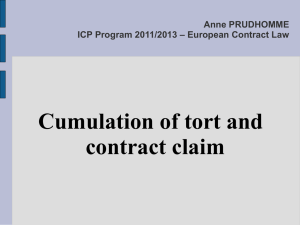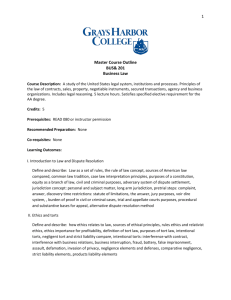the question of authority
advertisement
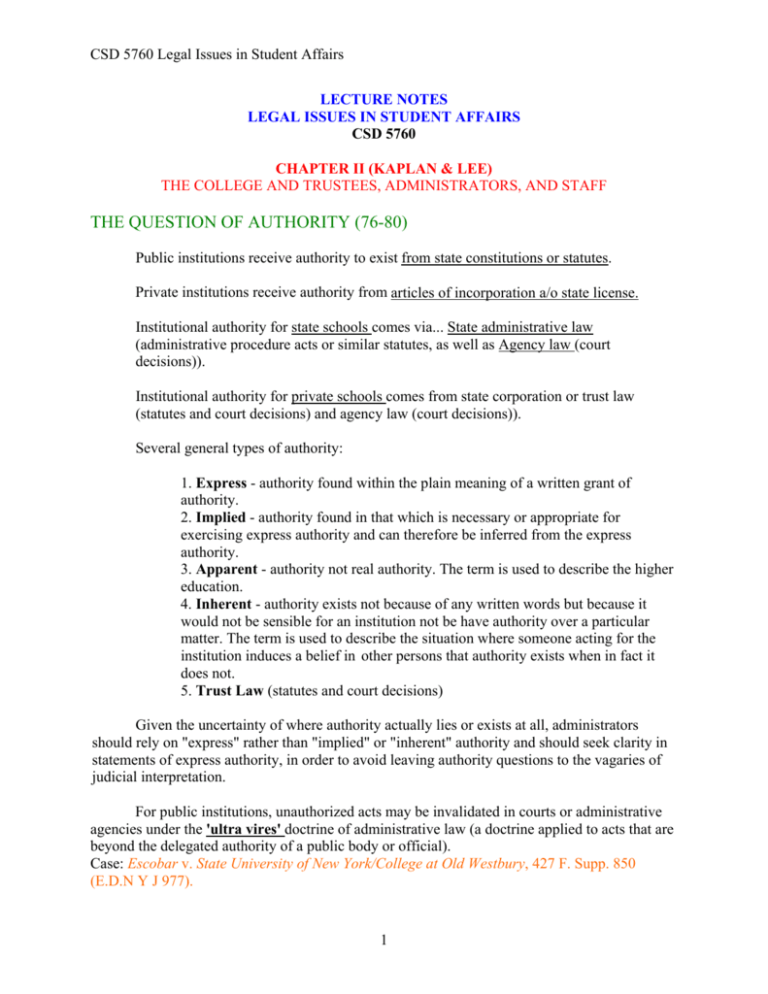
CSD 5760 Legal Issues in Student Affairs LECTURE NOTES LEGAL ISSUES IN STUDENT AFFAIRS CSD 5760 CHAPTER II (KAPLAN & LEE) THE COLLEGE AND TRUSTEES, ADMINISTRATORS, AND STAFF THE QUESTION OF AUTHORITY (76-80) Public institutions receive authority to exist from state constitutions or statutes. Private institutions receive authority from articles of incorporation a/o state license. Institutional authority for state schools comes via... State administrative law (administrative procedure acts or similar statutes, as well as Agency law (court decisions)). Institutional authority for private schools comes from state corporation or trust law (statutes and court decisions) and agency law (court decisions)). Several general types of authority: 1. Express - authority found within the plain meaning of a written grant of authority. 2. Implied - authority found in that which is necessary or appropriate for exercising express authority and can therefore be inferred from the express authority. 3. Apparent - authority not real authority. The term is used to describe the higher education. 4. Inherent - authority exists not because of any written words but because it would not be sensible for an institution not be have authority over a particular matter. The term is used to describe the situation where someone acting for the institution induces a belief in other persons that authority exists when in fact it does not. 5. Trust Law (statutes and court decisions) Given the uncertainty of where authority actually lies or exists at all, administrators should rely on "express" rather than "implied" or "inherent" authority and should seek clarity in statements of express authority, in order to avoid leaving authority questions to the vagaries of judicial interpretation. For public institutions, unauthorized acts may be invalidated in courts or administrative agencies under the 'ultra vires' doctrine of administrative law (a doctrine applied to acts that are beyond the delegated authority of a public body or official). Case: Escobar v. State University of New York/College at Old Westbury, 427 F. Supp. 850 (E.D.N Y J 977). 1 CSD 5760 Legal Issues in Student Affairs SOURCES AND SCOPE OF AUTHORITY (80-98) Delegation v. Sub-delegation v. Sub-sub-delegation - Authority given to subordinates by superiors such as the board of trustees. Tort - a wrongful act resulting in injury to another's person, property, or reputation, for which the injured party is entitled to seek compensation. Estoppel- Under this doctrine, courts may treat the unauthorized act of its employees as if it had been authorized. I.E., Administrators should avoid the appearance of appearance of authority because the institution may be held accountable, under the doctrine of "estoppel," for the damages suffered by another person who relied to their detriment on an appearance of authority. The inherent authority concept is often loosely used in judicial opinions and has no clear definition. However, it is most often used in reference to higher education. Case: Morris v. Nowotny, 323 S. W22d 301 (Tex. 1959) in which the court remarked that the statutes establishing the University of Texas "imply the power”, and if they do not so imply, then the power is inherent in university officials to maintain proper order and decorum on the premises of the university. OFFICERS AND ADMINISTRATORS (87-90) Lowest to highest ranking officers receive their authority from subdelegation by the institution's board of trustees. Estoppel Cases: Tuskegee Institute v. May Refrigeration Co., 344 So. 2d 156 (Ala. 1977). And Blank v, Board of Education of the City of New York, 273 NYS.2d 796 (NY Sup, Ct. 1966). THE COLLEGE'S STAFF (90 – 91) The core of the legal relationship between institutions and (non faculty) staff members is Contract Law. However, labor relations law, employment discrimination law, constitutional law and public employment statutes and regulations also play an increasingly important role in defining these relationships. Interchangeable terms: Contract, notice of appointment, lengthy collective bargaining agreements, faculty/staff handbook or institutional policy manual. Contracts are governed by common law, which may vary considerably by state. Employee Due Process Cases: Regents v. Roth, 408 U.S. 564 (1972), and Perry v. Sindermann, 408 U.S. 593 (1972) in which the Supreme Court established that public employees have a right to a fair hearing whenever the personnel decision deprives them of a "property interest" or a "liberty interest" under the XIV Amendment ("states shall not deprive any person of life, liberty, or property, without due process of law"). 2 CSD 5760 Legal Issues in Student Affairs Race discrimination in employment is prohibited by Title VII of the Civil Rights Act of 1964 and by Executive Order 11246. Sex discrimination is prohibited by Title VII, by Title IX of the Education Amendments of 1972, by the Equal Pay Act, and by Executive Order 11246. Age discrimination is outlawed by the Age Discrimination in Employment Act. Discrimination against employees with disabilities is prohibited by both the Americans with Disabilities Act and the Rehabilitation Act of 1973. National Origin discrimination is prohibited by Title VII and by Executive Order 11246. Alien discrimination is prohibited specifically by the Immigration Reform and Control Act and indirectly under Title VII. Veteran discrimination is prohibited by 38 U.S.C. sec. 4212. Race-or gender-employment decisions - must meet the affirmative action standards elaborated by the U.S. Supreme Court in Weber v. Kaiser Aluminum Co., 443 U.S. 193 (1979). Staff whose contracts have expired or staff who are at-will (who do not have a term contract and are not protected by state law or regulation), are not entitled to due process protections under a property interest theory. CAMPUS ORGANIZATIONS (91 – 93) Case: Searle v. Regents of the University of California, 100 Cal. Rptr. 194 (Cal. Ct. App. 1072). In which university administrators did not want to give students credit for course taught by Eldridge Cleaver. Court backed Regents on basis of 'academic senate' not having authority to appoint faculty members, but authority specifically retained by Regents. Case: Student Association of the University of Wisconsin-Milwaukee v. Baum, 246 N.W.2d 622 (Wis. 1976). In which state legislature had passed a statute giving students specific authority to participate in organizational governance. CAPTIVE AND AFFILIATED ORGANIZATIONS (93 – 98) Examples include faculty assemblies, department faculties, academic senates, and student or university judicial systems. Affiliations may be close (captive) or loosely affiliated (semi-captive) 3 CSD 5760 Legal Issues in Student Affairs INSTITUTIONAL LIABILITY FOR ACTS OF OTHERS (98 – 142) In Ad Hoc Committee of Baruch Black and Hispanic Alumni Association v. Bernard M. Baruch College, 835 F.2d 980, plaintiff committee alleged that the college had improperly refused to recognize its proposed alumni association dedicated to the need of minority students. This was considered a violation of the 1st Amendment and the equal protection clause of the 14th Amendment. The Court of Appeals ruled in favor of the Alumni Association. Holdings: The institution should 1. focus on the purposes it seeks to fulfill, 2. focus on the degree of control it needs to attain or retain, and 3. focus on the consequences of particular structural relationships on the respective rights of the parties to act autonomously of one another 4. consider how the structural arrangements would affect the applicability of particular regulatory and tax laws to the institution's activities, 5. ascertain whether the institution may be liable for actions of the other entity. INSTITUTIONAL TORT LIABILITY (98 -114) Under the doctrine of respondeat superior, an employer is legally responsible for an employee's torts. Case: Foster v. Board of Trustees of Butler County Community College, 771 F.Supp. 1122 (D.Kan. 1991). In Mazart v. State, 441 NY. S. 2d 600 (N. Y. Ct. Cl. 1981), the Court of Claims noted two possible theories for holding postsecondary institutions liable: (1) that the student organization was acting as an agent of the institution, and the institution, as principal, is vicariously liable for its agents' torts (the respondeat superior doctrine); and (2) that the institution had a legal duty to supervise the student organization because the institution supported or provided the environment for the organization's operation. The court refused to apply either theory against the institution. In a second theory resulting from the Mazart case, the institution's purported "duty to control," became an issue in a case that, although it did not involve a trot claim, addressed issues similar to those addressed in tort actions against colleges. Negligence (103 -111) When the institution is not immune from negligence suits under either sovereign or charitable immunity, liability depends, first, on whether the institution's actions fit the legal definition of the tort with which it is charged; and second, on whether the institution's actions are covered one of the recognized defenses that protect against liability for the tort with which it is charged. …the general tort law principle "that the owner of property owes to invitees... the 4 CSD 5760 Legal Issues in Student Affairs duty of exercising reasonable care to keep the premises in a safe condition, or of warning invitees of hidden or concealed perils of which he knows or should have known in the exercise of reasonable care." In Kleinknecht v. Gettysburg College, 989 F.2d 1360 a federal appellate court applying Pennsylvania aw held that a special relationship existed between the college and a student who collapsed as a result of cardiac arrest and died during lacrosse practice, and that because of this special relationship, the college had a duty to provide treatment to the student in the event of such a medical emergency. In University of Denver v. Whitlock, 744 P.2d 54 (Colo. 1987), the Supreme Court of Colorado reversed a $5.26 million judgment against the Univ. of Denver for a student rendered a quadriplegic in a trampoline accident. In Nero v. Kansas State University, 861 P.2d 768 (Kan. 1983), the Kansas Supreme Court ruled that the rape of a student by a fellow student in a residence hall was reasonably foreseeable because the alleged rapist had been found guilty of an earlier sexual assault on campus. When an institution attempts to prohibit, or to control, inherently dangerous activities in which its students participate, a court may find that it has a duty to those students. In Furek v. Univ. of Delaware, 594 A.2d 506 (Del. 1991), the Supreme Court of Delaware ruled that the university's pervasive regulation of hazing during fraternity rush created a duty to protect students from injuries suffered as a result of that hazing. ALCOHOL CONSUMPTION AND NEGLIGENCE (107-108) Case: Bradshaw v. Rawlings, 612 F.2d 135 (3d Cir. 1979), in which a Delaware Valley College student was serious injured in an auto accident following the annual sophomore class picnic held off campus. Injured student was a passenger in a car driven by an intoxicated student. The concept of legal duty is neither rigid nor static. A court can create a new duty if it decides that a plaintiff should be entitled to legal protection against a defendant's conduct. DEFAMATION (111-112) 2nd typical tort asserted against a postsecondary institution is committed by the oral or written publication of matters that tends to injure a person's reputation. OTHER SOURCES OF TORT LIABILITY (112 – 114) 5 CSD 5760 Legal Issues in Student Affairs Students and staff who have AIDS or are HIV positive are protected by the Rehabilitation Act and the Americans with Disabilities Act. Potential tort issues include (1) invasion of privacy for breaches of confidentiality, (2) negligent treatment by student health service personnel, (3) assault and/or battery, and (4) intentional or negligent infliction of emotional distress. In Ross v. Creighton University, 740 F. Supp 1319 (N.D. Ill. 1990), a trial judge dismissed the claim by a former athlete that the university had failed to educate him and asserted that the student was ultimately responsible for his academic success. Four reasons for the above decision: 1. 2. 3. 4. There is no satisfactory standard of care by which to measure an educator's conduct. The cause of the student's failure to learn is inherently uncertain, as in the nature of damages. Permitting such claims would flood the courts with litigation and would thus place a substantial burden on educational institutions. The courts are not equipped to oversee the day-to-day operation of educational institutions. INSTITUTIONAL CONTRACT LIABILITY (114 – 117) INSTITUTIONAL LIABILITIES FOR VIOLATIONS OF FEDERAL CONSTITUTIONAL RIGHTS (117 – 126) PERSONAL LIABILITY OF TRUSTEES, ADMINISTRATORS, AND STAFF (126-137) PERSONAL TORT LIABILITY (126 - 131) PERSONAL CONTRACT LIABILITY (131 – 132) PERSONAL LIABILITY FOR VIOLATIONS OF FEDERAL CONSTITUTIONAL RIGHTS (132 -137) INSTITUTIONAL MANAGEMENT OF LIABILITY RISK (137 – 142) Sunni Solomon handout/presentation RISK A VOIDANCE AND RISK CONTROL (137) 6 CSD 5760 Legal Issues in Student Affairs RISK TRANSFER (137 -140) INSURANCE (137 – 139) HOLD-HARMLESS AND INDEMNIFICATION AGREEMENTS (139 - 140) RELEASES AND WAIVERS (140) RISK RETENTION (140) LEGAL LIMITS ON AUTHORITY TO TRANSFER RISK (140 – 142) 7


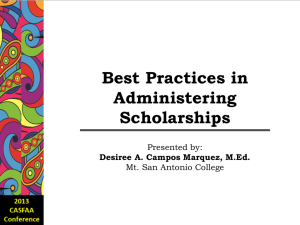
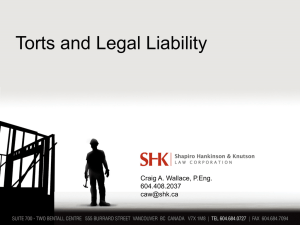

![Legal Phil Unit 8[1]](http://s2.studylib.net/store/data/005765299_1-dc4a11d7fcd357e684dc37049d520026-300x300.png)
